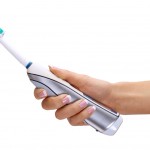
Regular toothbrushing with a fluoride toothpaste is a significant contributor to improved oral health. Toothbrushes are available in many designs and powered toothbrushes have been in use since the 1940s and Cochrane (Dental Elf – 18th Jun 2014) and other reviews have shown them to remove more plaque than manual brushes. The two main types of powered toothbrushes are oscillating-rotating and high-frequency sonic power brushes.
The aim of this review was to compare the efficacy of oscillating-rotating power toothbrush compared to high-frequency sonic power toothbrush on improving parameters of plaque and gingival inflammation.
Methods
A review protocol was registered in PROSPERO and searches conducted in the Medline/PubMed and Cochrane Central Register of Controlled Trials (CENTRAL). Randomised or controlled clinical trials (RCTs, CCTs) comparing high-frequency sonic power toothbrush (HFS- PTB) with oscillating-rotating power toothbrush (OR-PTB) in patients aged 18 or older with a minimum of 4 weeks follow up and published in English were considered. Primary outcomes were plaque index scores (PI), bleeding scores (BS), number of bleeding sites (NoB), gingival index scores (GI). Two reviewers individually screened and selected studies, extracted data and assessed risk of bias with disagreements being resolved by consensus or with the aid of a third reviewer. Meta-analyses were conducted where appropriate and reported as mean difference (MD) with 95% confidence intervals (CIs). Certainty of evidence was assessed using the Grading of Recommendations Assessment, Development and Evaluation (GRADE) system.
Results
- 32 RCTs (30 parallel, 2 cross-over) including 38 comparisons involving a total of 2805 patients were included.
- Sample sizes ranged from 30 – 284 and ages from 18 – 83 years.
- Considerable heterogeneity was seen with respect to study design; evaluation period; study population and number, gender and age of patients.
- Risk of bias was assessed as low in 31 studies and moderate in one.
- Meta-analyses were based on 16 comparisons revealed that the MD was significant in favour of the OR-PTB for 4 indices (see table), but no significant differences were seen for Papillary Bleeding scores, Gingival Bleeding index or (Modified) Gingival Index.
| Index | Comparisons | Mean difference (95%CI) |
| Modified Quigley and Hein Plaque index | 16 | 0.13 (0.05 to 0.21) |
| (Rustogi) modified Navy Plaque index | 12 | 0.01 (0.00 to 0.03) |
| Angular Bleeding index Bleeding on Marginal Probing indices | 3 | 0.09 (0.03 to 0.14) |
| Number of Bleeding sites | 11 | 3.61 (2.63 to 4.58) |
- The certainty of the evidence was considered to be moderate.
Conclusions
The authors concluded: –
For patients to maintain good plaque control and improve gingival health, there is a small but significant difference based on longer-term studies between OR-PTB and HFS-PTB. This difference is potentially clinically relevant.
Comments
The authors searched two major databases and restricted their included studies to those published in English which may have excluded some relevant studies. The reviewers have followed a standard review methodology identifying 32 RCTs meeting their criteria. The publication is an extensive open-source paper than includes a detailed supplementary data file. The data suggest a small benefit in favour of the oscillating-rotating brush which the authors suggest may be clinically relevant. Many of the included studies (62%) received funding from commercial companies and there is some suggestion from funnel plot assessment of some form of publication bias which may have implications for the findings. While this review demonstrates very little differences between these two main types of powered brushes the cost and reliability of these brushes needs to be considered and although powered brushes reduce plaque and gingivitis more than manual toothbrushing regular use of a manual brush remains and effective method of maintaining oral hygiene.
Links
Primary Paper
van der Sluijs E, Slot DE, Hennequin-Hoenderdos NL, Valkenburg C, van der Weijden FGA. The efficacy of an oscillating-rotating power toothbrush compared to a high-frequency sonic power toothbrush on parameters of dental plaque and gingival inflammation: A systematic review and meta-analysis. Int J Dent Hyg. 2022 May 10. doi: 10.1111/idh.12597. Epub ahead of print. PMID: 35535635.
Other references
Dental Elf – 18th Jun 2014
Powered toothbrushes reduced plaque and gingivitis more than manual toothbrushes
Dental Elf – Powered toothbrushes blogs
